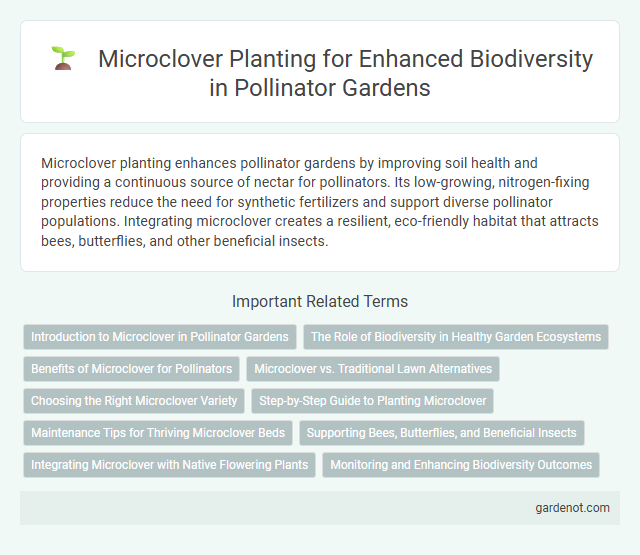Microclover planting enhances pollinator gardens by improving soil health and providing a continuous source of nectar for pollinators. Its low-growing, nitrogen-fixing properties reduce the need for synthetic fertilizers and support diverse pollinator populations. Integrating microclover creates a resilient, eco-friendly habitat that attracts bees, butterflies, and other beneficial insects.
Introduction to Microclover in Pollinator Gardens
Microclover, a low-growing and nitrogen-fixing legume, thrives in pollinator gardens by providing high-density ground cover that enhances soil fertility naturally. Its small, dense leaves create a lush carpet that supports pollinators such as bees and butterflies by maintaining moisture and offering forage throughout the growing season. Integrating microclover with flowering plants boosts biodiversity, improves garden resilience, and reduces the need for synthetic fertilizers, thereby creating an eco-friendly habitat for pollinators.
The Role of Biodiversity in Healthy Garden Ecosystems
Microclover planting enhances biodiversity by providing ground cover that supports diverse pollinator species, improving soil health and reducing weed growth. Its nitrogen-fixing properties enrich the soil naturally, promoting a balanced ecosystem that sustains beneficial insects and microorganisms. Increasing plant diversity with microclover contributes to resilient pollinator gardens, fostering ecosystem stability and productivity.
Benefits of Microclover for Pollinators
Microclover enhances pollinator gardens by providing high-quality nectar and pollen that attract bees, butterflies, and other beneficial insects. Its dense, low-growing foliage creates a habitat rich in shelter and moisture, supporting diverse pollinator populations throughout the growing season. This ground cover also improves soil health by fixing nitrogen, promoting robust plant growth and sustaining healthy floral resources for pollinators.
Microclover vs. Traditional Lawn Alternatives
Microclover offers a sustainable alternative to traditional lawn grasses by improving soil health and reducing the need for fertilizers due to its nitrogen-fixing properties. Unlike conventional lawns, microclover requires less mowing and water, making it ideal for pollinator gardens seeking eco-friendly ground cover. Its dense growth supports pollinator habitats by providing nectar sources and enhancing biodiversity compared to monoculture grass lawns.
Choosing the Right Microclover Variety
Selecting the right microclover variety for a pollinator garden depends on local climate, soil type, and sunlight exposure to ensure optimal growth and nitrogen fixation. Popular varieties like Microclover 'Dutch' and 'Isabella' offer drought tolerance and dense ground cover, supporting diverse pollinator habitats. Matching the microclover cultivar to regional conditions enhances bloom density, attracts beneficial insects, and improves overall garden sustainability.
Step-by-Step Guide to Planting Microclover
Prepare the soil by removing weeds and loosening the top layer for optimal microclover seed contact. Evenly scatter microclover seeds over the prepared soil, ensuring a thin, consistent coverage of approximately 1-2 ounces per 1,000 square feet. Lightly rake the area to cover the seeds with soil, then water gently but thoroughly to keep the soil consistently moist until germination occurs in 7 to 14 days.
Maintenance Tips for Thriving Microclover Beds
Microclover beds require minimal mowing, ideally cut to a height of 3-4 inches to promote healthy growth and prevent stress. Regular watering during dry spells ensures consistent moisture without waterlogging the soil, supporting deep root development. Periodic overseeding every 2-3 years helps maintain thick coverage and suppresses weed intrusion for a resilient pollinator garden.
Supporting Bees, Butterflies, and Beneficial Insects
Microclover planting enriches pollinator gardens by providing a dense, nitrogen-fixing ground cover that supports bees, butterflies, and beneficial insects with continuous nectar and pollen sources. Its low-growing habit reduces weed competition and maintains soil moisture, creating a favorable habitat for diverse pollinator species. Incorporating microclover enhances ecosystem health while boosting garden biodiversity through sustainable soil improvement and food availability.
Integrating Microclover with Native Flowering Plants
Integrating microclover with native flowering plants enhances pollinator garden diversity by improving soil nitrogen fixation and providing continuous ground cover. Native wildflowers such as Echinacea purpurea and Asclepias tuberosa complement microclover's low-growing habit, attracting a wide range of bees, butterflies, and other pollinators. This combination supports ecosystem resilience, promotes better moisture retention, and reduces weed competition for a thriving pollinator habitat.
Monitoring and Enhancing Biodiversity Outcomes
Microclover planting in pollinator gardens significantly boosts biodiversity by providing continuous ground cover and nectar sources that support diverse pollinator species. Regular monitoring of microclover health, flowering patterns, and pollinator visitation rates helps optimize habitat conditions and detect early signs of pest or disease pressures. Enhancing biodiversity outcomes involves adaptive management practices such as adjusting planting density and integrating complementary native flowering plants to sustain pollinator populations and ecosystem resilience.
Microclover planting Infographic

 gardenot.com
gardenot.com